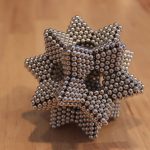Magnet Myths Debunked
We're here to share our mega magnet knowledge and debunk some magnet myths. Let's get started!
Myth #1: Magnets Last Forever
While magnets like neodymium and samarium cobalt are incredibly long-lasting, all magnets eventually lose strength over time, especially when exposed to heat, strong opposing magnetic fields, or physical shock. The truth: Under normal conditions, a high-quality permanent magnet can retain its strength for decades—but not forever. If your application involves high heat or heavy vibration (think motors, sensors, or assembly equipment), choose a material like SmCo for added stability.
Myth #2: Stronger Magnets Are Always Better
Not so fast. Neodymium magnets indeed are some of the strongest on Earth, but strength isn’t always the top priority. The truth: The “best” magnet depends on your use case. Overengineering your magnet can lead to unnecessary costs or even safety issues.
For example, teaching magnetic fields in a classroom? Ceramic magnets are safer and more cost-effective. Working near sensitive electronics or components that might corrode? A coated or corrosion-resistant magnet might serve better than a raw NdFeB.
Myth #3: Magnets Work Through Anything
Magnets are powerful, but not omnipotent. The truth: Magnetic fields can pass through most non-magnetic materials like plastic, wood, and glass—but distance and thickness matter. Materials like steel can block, redirect, or even absorb magnetic fields. This is why magnetic shielding exists—to deliberately block fields from reaching sensitive areas. Always consider the thickness and composition of any barrier between your magnet and the object it’s supposed to attract.
Myth #4: All Magnets Are Basically the Same
If you’ve seen one, you’ve seen them all? Not quite. The truth: Magnetic materials vary widely in strength, durability, temperature tolerance, and cost. Neodymium, ceramic, alnico, and samarium cobalt all behave differently—sometimes drastically so. Choosing the right magnet is like choosing the right material for a bridge vs. a bookshelf. Both are important, but the stakes (and specs) are very different.
Myth #5: Magnets Are Dangerous (and Should Be Avoided)
Let’s be clear: magnets are powerful tools, but they’re incredibly safe and effective with proper handling. The truth: While some industrial-strength magnets can pinch or snap if mishandled, safety comes down to education and usage—not fear.
Magnets are science in action, and like any tool, they’re most effective when you know what you’re working with. By busting these common myths, we hope you feel empowered to confidently choose the right magnetic solution for your business or classroom.
Safety Warning: Children should not be allowed to play with neodymium magnets as they can be dangerous. Small magnets pose a choking hazard and should never be swallowed or inserted into any part of the body. Magnets can be dangerous. Neodymium magnets, especially, must be handled with care to avoid personal injury and damage to the magnets. Fingers and other body parts can get severely pinched between two attracting magnets. Bones can be broken by larger magnets. Visit our Magnet Safety page to learn more.
Even More Magnets
At Apex Magnets, we provide handling guidelines and strength ratings to help you safely incorporate magnets into your workflows—whether it’s R&D, production, or packaging.
Have a question about material choice, custom sizing, or magnetic strength? Our team is here to help—no myths, just facts. Contact us today. Ready to shop? Explore our full lineup of magnetic materials or reach out for expert support.
Finally, subscribe to our monthly newsletter! You’ll be among the first to receive notifications about our latest blogs and discounts for our latest magnet deals.

